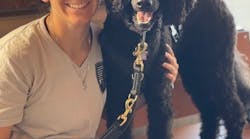July 14--SAN ANGELO, Texas -- Shooting down clay birds recently enabled Shannon Medical Center to continue safely landing its own bird and maintain its long relationship with first responders in the area.
Shannon purchased 325 small, heavy-duty lights: four yellow and one red, each set packed into a bag. The purchase of the lights, at an overall cost of $15,535, was made possible by proceeds from a benefit sporting clay bird shoot last year. The bags were to be distributed to first responding units in the 17 counties AirMed 1 -- Shannon's medical helicopter -- covers in a 150-mile radius around San Angelo.
Flight nurse Cindy Gurley, who also acts as the marketing person for AirMed 1, was in charge of distributing the lights, which are used to guide the medical helicopter to a safe landing at any scene where it needs to pick up a patient. She trained the outlying first responders how to properly place the lights and seized that opportunity to further strengthen the flight crew's relationship with those they deal with on a regular basis.
As AirMed 1 recently celebrated its 20 years at Shannon, Gurley views the time spent with all first responders, not just in an emergency setting, valuable to maintain a successful track record.
"We're always giving training. Lately there has been quite a bit of training for the oil rigs," Gurley said. "Rig sites are particularly dangerous to land at, particularly with everything being so dry. It can get so bad that the pilot can lose all visibility."
Pilot Jack Hyde said the most common scene AirMed 1 responds to is vehicle crashes on the highway. In the past few years, he said, oil rig accidents have become more common and are the clear cut No. 2 scene.
AirMed 1 averages about one call a day, flight nurse Judee Garrett said. Last year the helicopter flew 379 flights, she said, and about the same number were turned down because of maintenance issues or weather.
When an emergency comes over from dispatch, a Shannon communication technician will call the pilot on duty to ask whether the crew can fly to a specific destination, Garrett said. Based solely on the weather, the pilot will say "yes or no" without knowing anything else about the nature of the call.
"They're not told anything about the patient so the pilot does not push the safety envelope for the type of patient," Garrett said. "Suppose you're the pilot and you've got an 8-month-old at home and you're going to help an 8-month-old, then you may be more inclined to push the safety envelope. If we don't take the flight, he doesn't need to know. Eventually, if we are in the air he will find out because of radio traffic. He will find out if we are going to either a facility or a scene."
In the event AirMed 1 can't take a flight, it will call other air ambulance services about the emergency. The nearest medical helicopters are stationed in Abilene, Snyder, Big Spring and San Marcos.
Teresa Kreager, a communication technician who dispatches AirMed 1 and tracks air traffic and weather, said the busiest day she experienced, with multiple helicopters dispatched, was in November 2011. An Abilene Christian University bus carrying 16 passengers overturned one afternoon on a remote part of U.S. 83 between Ballinger and Paint Rock.
"As soon as Runnels (County dispatch) called me and told me what we had, we started calling every helicopter we had immediately to come to the accident scene. We ended up with seven responding and six transporting patients (to Shannon). That's the biggest one I've ever worked," Kreager said.
Sean McCallum, a retired firefighter who has been a flight nurse for the entire 20 years with AirMed 1, said he has seen the helicopter service evolve.
"The equipment's gotten better. Our crews have gotten better. More training, more experience. Night vision goggles on every flight," McCallum said. "Before the night vision goggles, it was a lot more treacherous. We would rely on the ground crews a lot. Now, we can find the hazards and point them out to the pilot."
The AirMed 1 crew is constantly looking at ways to improve. After each flight, a debriefing with the pilot, medical crew and communications center is done. They discuss what went right and what went wrong and how to improve. Comment cards are given out to the people contacted by AirMed 1, be it patients or first responders, Garrett said.
There are guidelines the crew tries to follow with each flight. During the day, liftoff should be under 10 minutes, and under 15 minutes for the night. AirMed 1 doesn't want to be on any scene for longer than 20 minutes, and no longer than 30 minutes for a facility, Garrett said.
A huge notebook in the AirMed 1 office keeps track of those reports and comment cards. The flight crew analyzes them frequently and constantly looks at room for improvement.
The flight nurses have to endure more training than the average nurse because they have to be able to handle every kind of trauma, Garrett said. On every flight, the crew takes two units of blood in case a transfusion is needed, she said. Paramedics cannot perform blood transfusions in an ambulance on the road.
"One of the big components with AirMed 1 is that the 1 doesn't mean that we're No. 1. It stands for the golden hour," Garrett said.
"The best care we can provide for that patient, including blood transfusions, happens during that golden hour for a much better outcome with more positive results. That's what we're always striving for."
Copyright 2014 - San Angelo Standard-Times, Texas





